
A cappuccino is an espresso-based coffee drink that originated in Italy, and is traditionally prepared with steamed milk foam (microfoam).
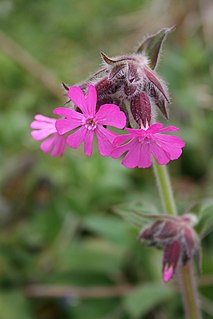
Silene is a genus of flowering plants in the family Caryophyllaceae. Containing nearly 900 species, it is the largest genus in the family. Common names include campion and catchfly. Many Silene species are widely distributed, particularly in the northern hemisphere.

A barista is a person, usually a coffeehouse employee, who prepares and serves espresso-based coffee drinks.
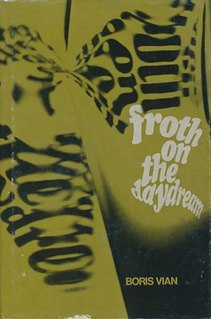
Froth on the Daydream is a 1947 novel by French author Boris Vian. Though told as a linear narrative, the novel employs surrealism and contains multiple plot lines, including the love stories of two couples, talking mice, and a man who ages years in a week. One of the main plot lines concerns a newlywed man whose wife develops a rare and bizarre illness that can only be treated by surrounding her with flowers.

Copper extraction refers to the methods used to obtain copper from its ores. The conversion of copper consists of a series of physical and electrochemical processes. Methods have evolved and vary with country depending on the ore source, local environmental regulations, and other factors.

Froth flotation is a process for selectively separating hydrophobic materials from hydrophilic. This is used in mineral processing, paper recycling and waste-water treatment industries. Historically this was first used in the mining industry, where it was one of the great enabling technologies of the 20th century. It has been described as "the single most important operation used for the recovery and upgrading of sulfide ores". The development of froth flotation has improved the recovery of valuable minerals, such as copper- and lead-bearing minerals. Along with mechanized mining, it has allowed the economic recovery of valuable metals from much lower grade ore than previously.
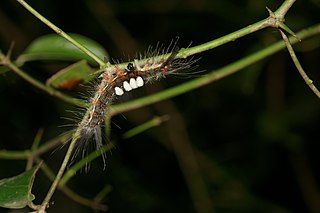
The Lymantriinae are a subfamily of moths of the family Erebidae. The taxon was erected by George Hampson in 1893.

Latte macchiato is a coffee beverage; the name means stained or marked milk. Marked as in an espresso stain on the milk used. It is a play on “Espresso macchiato” which is an espresso with a drop or two of milk or cream.

A flat white is a coffee drink consisting of espresso with microfoam. It is comparable to a latte, but smaller in volume and with less microfoam, therefore having a higher proportion of coffee to milk, and milk that is more velvety in consistency – allowing the espresso to dominate the flavour, while being supported by the milk.
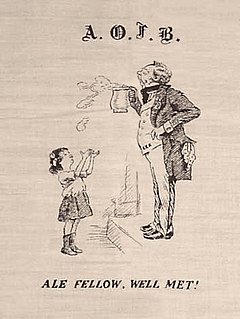
The Ancient Order of Froth-Blowers was a humorous British charitable organisation "to foster the noble Art and gentle and healthy Pastime of froth blowing amongst Gentlemen of-leisure and ex-Soldiers". Running from 1924–1931, it was founded by Ronald Frothington Noble an ex-soldier and curtain-merchant, initially to raise £100 for the children's charities of the surgeon Sir Alfred Fripp. One of the Order's first meeting places was the Swan, Fittleworth, W. Sussex – the 'No. 0 Vat'.
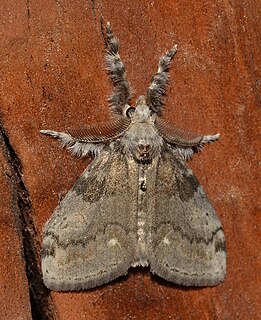
Orgyia leucostigma, the white-marked tussock moth, is a moth in the family Erebidae. The species was first described by James Edward Smith in 1797. The caterpillar is very common especially in late summer in eastern North America, extending as far west as Texas, California, and Alberta.
The Secret World of Benjamin Bear is a Canadian animated television series and a joint effort produced by Amberwood Entertainment, Secret Bear Productions, and produced with the participation of Bell Broadcast and New Media Fund including animation by Philippine Animation Studio Inc.. It originally aired on Family Channel from 2003-2009. 52 episodes were produced.
Foam fractionation is a chemical process in which hydrophobic molecules are preferentially separated from a liquid solution using rising columns of foam. It is commonly used, albeit on a small scale, for the removal of organic waste from aquariums; these units are known as "protein skimmers". However it has much broader application in the chemical process industry and can be used for the removal of surface active contaminants from waste water streams in addition to the enrichment of bio-products.
Deinking is the industrial process of removing printing ink from paperfibers of recycled paper to make deinked pulp.
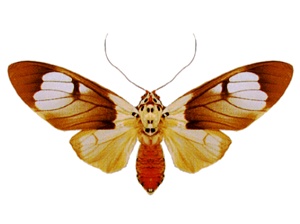
Amerila crokeri, or Croker's frother, is a moth of the subfamily Arctiinae. The species was first described by William Sharp Macleay in 1826. It is found in the Australian states of New South Wales and Queensland and on New Guinea and New Britain.

Marocchino is a coffee drink created in Alessandria, Italy. It is served in a small glass and consists of a shot of espresso, cocoa powder and milk froth. In some regions of northern Italy, thick hot cocoa is added. In Alba, the home of the Italian chocolate giant Ferrero, Nutella is used. The name Marocchino is derived from its colour, as marocchino was a type of light brown leather used in the 1930s to make hair bands.

Amerila serica is a moth of the subfamily Arctiinae first described by Edward Meyrick in 1886. It is found in the Australian states of New South Wales and Queensland.
Amerila timolis, or Timolis' frother, is a moth of the subfamily Arctiinae. It was described by Walter Rothschild in 1914. It is found in New Guinea and Queensland, Australia.
Bitumen froth treatment is a process used in the Athabasca oil sands (AOS) bitumen recovery operations to remove fine inorganics—water and mineral particles—from bitumen froth, by diluting the bitumen with a light hydrocarbon solvent—either naphthenic or paraffinic—to reduce the viscosity of the froth and to remove contaminants that were not removed in previous water-based gravity recovery phases. Bitumen with a high viscosity or with too many contaminants, is not suitable for transporting through pipelines or refining. The original and conventional naphthenic froth treatment (NFT) uses a naphtha solvent with the addition of chemicals. Paraffinic Solvent Froth Treatment (PSFT), which was first used commercially in the Albian Sands in the early 2000s, results in a cleaner bitumen with lower levels of contaminates, such as water and mineral solids. Following froth treatments, bitumen can be further upgraded using "heat to produce synthetic crude oil by means of a coker unit."
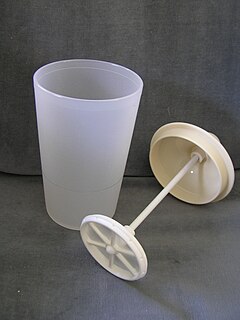
A milk frother is a utensil for making milk froth, typically to be added to coffee. It aerates the milk, creating a thick and heavy foam. The tiny bubbles, which are formed during this process, make the milk texture lighter and increase its volume. There are three major types of milk frother: manual, handheld electric, and automatic. Some devices can warm the milk while making froth.















